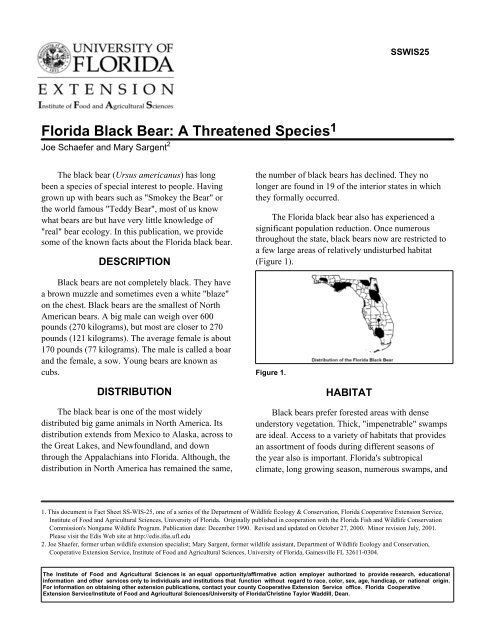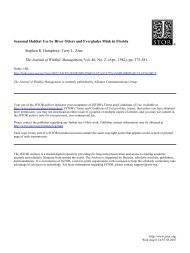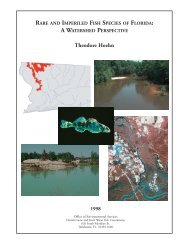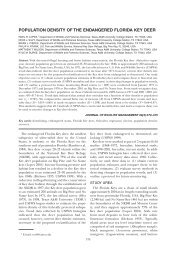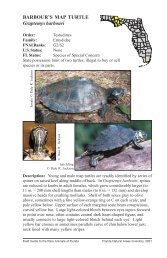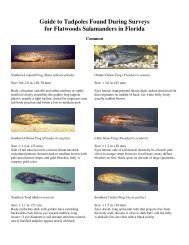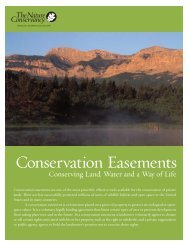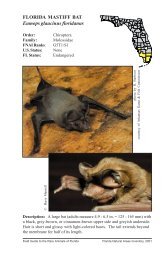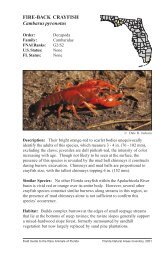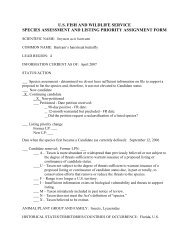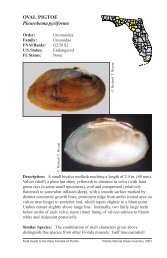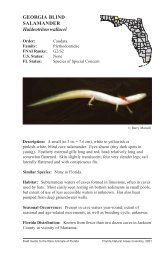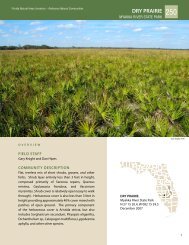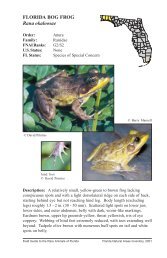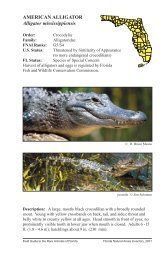Florida Black Bear: A Threatened Species - Florida Wildlife ...
Florida Black Bear: A Threatened Species - Florida Wildlife ...
Florida Black Bear: A Threatened Species - Florida Wildlife ...
- No tags were found...
Create successful ePaper yourself
Turn your PDF publications into a flip-book with our unique Google optimized e-Paper software.
SSWIS25<strong>Florida</strong> <strong>Black</strong> <strong>Bear</strong>: A <strong>Threatened</strong> <strong>Species</strong> 1Joe Schaefer and Mary Sargent 2The black bear (Ursus americanus) has longbeen a species of special interest to people. Havinggrown up with bears such as "Smokey the <strong>Bear</strong>" orthe world famous "Teddy <strong>Bear</strong>", most of us knowwhat bears are but have very little knowledge of"real" bear ecology. In this publication, we providesome of the known facts about the <strong>Florida</strong> black bear.DESCRIPTION<strong>Black</strong> bears are not completely black. They havea brown muzzle and sometimes even a white "blaze"on the chest. <strong>Black</strong> bears are the smallest of NorthAmerican bears. A big male can weigh over 600pounds (270 kilograms), but most are closer to 270pounds (121 kilograms). The average female is about170 pounds (77 kilograms). The male is called a boarand the female, a sow. Young bears are known ascubs.DISTRIBUTIONThe black bear is one of the most widelydistributed big game animals in North America. Itsdistribution extends from Mexico to Alaska, across tothe Great Lakes, and Newfoundland, and downthrough the Appalachians into <strong>Florida</strong>. Although, thedistribution in North America has remained the same,the number of black bears has declined. They nolonger are found in 19 of the interior states in whichthey formally occurred.The <strong>Florida</strong> black bear also has experienced asignificant population reduction. Once numerousthroughout the state, black bears now are restricted toa few large areas of relatively undisturbed habitat(Figure 1).Figure 1.HABITAT<strong>Black</strong> bears prefer forested areas with denseunderstory vegetation. Thick, "impenetrable" swampsare ideal. Access to a variety of habitats that providesan assortment of foods during different seasons ofthe year also is important. <strong>Florida</strong>'s subtropicalclimate, long growing season, numerous swamps, and1. This document is Fact Sheet SS-WIS-25, one of a series of the Department of <strong>Wildlife</strong> Ecology & Conservation, <strong>Florida</strong> Cooperative Extension Service,Institute of Food and Agricultural Sciences, University of <strong>Florida</strong>. Originally published in cooperation with the <strong>Florida</strong> Fish and <strong>Wildlife</strong> ConservationCommission's Nongame <strong>Wildlife</strong> Program. Publication date: December 1990. Revised and updated on October 27, 2000. Minor revision July, 2001.Please visit the Edis Web site at http://edis.ifas.ufl.edu2. Joe Shaefer, former urban wildlife extension specialist; Mary Sargent, former wildlife assistant, Department of <strong>Wildlife</strong> Ecology and Conservation,Cooperative Extension Service, Institute of Food and Agricultural Sciences, University of <strong>Florida</strong>, Gainesville FL 32611-0304.The Institute of Food and Agricultural Sciences is an equal opportunity/affirmative action employer authorized to provide research, educationalinformation and other services only to individuals and institutions that function without regard to race, color, sex, age, handicap, or national origin.For information on obtaining other extension publications, contact your county Cooperative Extension Service office. <strong>Florida</strong> CooperativeExtension Service/Institute of Food and Agricultural Sciences/University of <strong>Florida</strong>/Christine Taylor Waddill, Dean.
<strong>Florida</strong> <strong>Black</strong> <strong>Bear</strong>: A <strong>Threatened</strong> <strong>Species</strong> 2diverse vegetation types provide excellent conditionsfor this species.DIET<strong>Black</strong> bears are omnivorous (eat meat andplants) and need an average of 11-18 pounds (5-8kilograms) of food each day. They feed on almost anysucculent, nutritious vegetation (tubers, bulbs,berries, nuts, and young shoots). The food items eatenmost often and in the greatest volumes are seasonallyavailable fruits and colonial insects.The fruits of saw palmetto, cabbage palm, swamptupelo, and oaks are preferred plant foods in fall. Thehoney bee is the most frequently eaten insect andarmadillos are the most commonly eaten vertebrate.BEHAVIOR AND HOME RANGE<strong>Black</strong> bears usually are solitary except for thesow and her cubs. There also are brief periods such asbreeding season encounters when bears may be foundtogether.The area regularly used by 1 adult male bear maybe larger than 66 square miles (177 squarekilometers). An adult female's home range is usuallycloser to 11 square miles (28 square kilometers).<strong>Bear</strong>s are most active at night (nocturnal). Theyalso tend to reduce their movements during thecoldest months of the year. This probably is due to adecrease in food availability. During this period, bearsmay "hole up" until more favorable conditions occur.They are true hibernators and individuals have beendocumented to sleep for more than two months at atime. One of the most common winter sleeping sitesused by <strong>Florida</strong> bears is a bed of vegetation located ina thicket. Probably because of our relatively mildwinters bears do not always hibernate in <strong>Florida</strong>.REPRODUCTION<strong>Black</strong> bears have been found to be moreproductive in <strong>Florida</strong> than in other states. <strong>Black</strong> bearsbreed in May-July. Gestation (pregnancy) lasts210-215 days. One to 3 cubs are born in January orFebruary, and stay with the mother for approximately1 1/2 years. Males do not assist in raising the youngnor is there a long-lasting pair bond for this species.LEGAL STATUSThe <strong>Florida</strong> black bear was listed by the state as athreatened species, in 1974. This status applies to theentire state except for Baker and Columbia countiesand the Apalachicola National Forest. Hunting the<strong>Florida</strong> black bear is prohibited throughout the entirestate.This subspecies of black bear is in danger ofbecoming extinct because of extensive habitat loss,not because of hunting. The original, heavily forested,prime bear habitats in <strong>Florida</strong> have and are beingaltered to accommodate the needs of hundreds ofpeople moving into the state every day. Forests arebeing cleared and fragmented into areas too small tosupport healthy bear populations or in some caseseven single animals.Roadkills also are a major problem in areaswhere highways have cut through remaining bearhabitat. <strong>Bear</strong>s can run at a speed of about 30 mph forshort distances; however, determining the best escapealternative while looking into the headlights of ahigh-speed vehicle is too great a challenge for theblack bear and other species.MANAGEMENTThe future of the <strong>Florida</strong> black bear is dependenton preservation of sufficient forest habitats throughgrowth management and proper management of theseforests. Because there are many unansweredquestions concerning basic bear biology, scientificresearch also is necessary to help determine the mosteffective management practices.Proper management of habitats is necessary tosatisfy the black bear's varied diet. Managementpractices should strive to allow for a high diversity ofplants. Converting naturally diverse flatwood andhardwood communities into slash pine plantationswith very few other plants may reduce importantfoods for the black bear.Management also is needed to reduce the numberof road-killed bears. Some recommendations thatmay help to prevent bears from crossing highwaysinclude: fencing constructed parallel to the roadway,and underpasses (corridors) where bears regularly
<strong>Florida</strong> <strong>Black</strong> <strong>Bear</strong>: A <strong>Threatened</strong> <strong>Species</strong> 3cross roads. Signs also should be placed alonghighways to alert drivers of areas where the potentialfor animal-vehicle collisions is greatest. Constructionof new highways and upgrading of existing highwaysfor high speed, high volume traffic through importantbear habitat should be avoided.Maehr, D. S. and J. R. Brady. 1984. Proc. of the7th Eastern Workshop on <strong>Black</strong> <strong>Bear</strong> Research andManagement. <strong>Florida</strong> Game and Fresh Water FishCommission. 88pp.BEARS AND BEEKEEPING<strong>Florida</strong> black bear habitat is also good habitat forhoney bees. A management approach is necessary toaddress the problem that bears cause beekeepers.<strong>Florida</strong> is a large producer of honey and black bearraids on apiaries can result in serious economicdamages. The best method to prevent bear damage tobee yards is to surround the yard with a wellmaintained electric fence. The <strong>Florida</strong> Fish and<strong>Wildlife</strong> Conservation Commission will providetechnical guidance in the use of this alternative beforeother methods of control are considered. The electricfence design developed and proven effective by theCommission is in Figure 2 .Figure 2.Some construction tips are: 1) corner posts mustbe secured with guide wires; 2) wires must bestretched very tightly; 3) vegetation must be removeddown to mineral soil beneath wires; and 4) on dryridges, run additional ground wires to ground rods atall 4 corners. Materials for construction of a 75 x 30foot (25 x 10 meter) rectangular fence cost about$150.SELECTED REFERENCESBrody, A. J. 1989. "Effects of roads on blackbear movements in western North Carolina". <strong>Wildlife</strong>Society Bulletin 17:5-10.Brady, J. R., and D. S. Maehr. 1985."Distribution of black bears in <strong>Florida</strong>". <strong>Florida</strong> FieldNaturalist 13(1):1-24.


